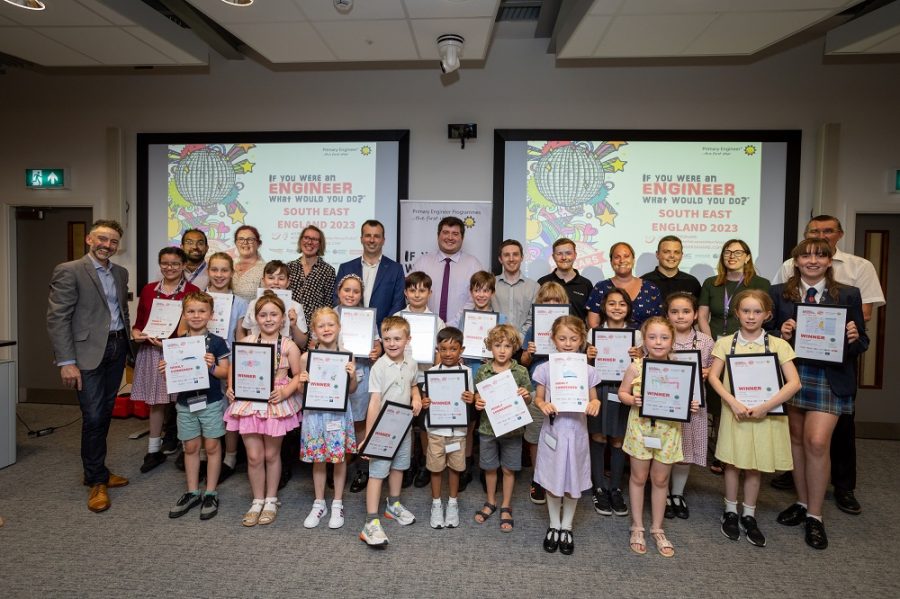
Primary Engineer and Canterbury Christ Church University celebrates with young engineers and their award-winning ideas
School students from across the south east were welcomed to Canterbury Christ Church University recently to receive awards and celebrate their innovative engineering designs aimed at solving real-world problems.
All the young people had taken part in the Primary Engineers Leaders Award. The national competition, now in its tenth year, saw over 48,000 students across the UK take part. It asks students from 3 to 19 years old: “If you were an engineer, what would you do?” and it encourages them to come up with creative solutions to problems they identify in their lives and the world around them.
The competition aims to spark an interest in engineering and provides an opportunity for young people to meet with local engineers and ask questions about their careers and what motivates them. Students are then encouraged to look at the world around them to find problems that an engineer could solve and to submit their designs to the competition. Each entry is then judged by local engineers and academics. The University, one of the competition’s partners for this region, helped grade these entries. Every entry receives a certificate and a grade, and then a selection of entries are shortlisted and chosen as winners.

Some of the winning designs included robots to help sick people, hair scrunchies with emergency buttons to help alert people of your location and an automated bookshelf that can find the exact book you are looking for.
Chris Rochester, UK Director of Primary Engineer, said: “For a decade we have been working with young people to inspire the next generation of engineers, with Canterbury Christ Church University as our south east partner for five of those years.
“Every year we are wowed by the innovative designs that we see. All of these young people are extraordinary and their creativity and empathy to solve problems to help people or the world around them is inspiring to see.”

Preston decided on his design not only as a way of avoiding going out in the cold but also for any accidents or injuries whilst clearing snow from drives and paths. The robot has a heated scoop to clear the snow, which it places in a reservoir. Once melted, the water can be used elsewhere to help preserve water. The robot is also able to scatter rock salt on the cleared paths to prevent refreezing. It also has a GPS sensor so it can identify the precise area to be cleared, Bluetooth so it can be controlled from inside, a rechargeable battery and solar charging options.
Preston said: “I already had an idea for the design before I entered the competition, but I had fun trying to make the design better for the competition. I don’t normally win things, so this feels really good.
“I would like to be an engineer and inventor. I like to try to make things better.”
Once again, the young people this year have excelled in their designs. Children are not inhibited with their ideas to solve problems and there is a lot we should be learning from young people about how to solve problems. It is so amazing to work with Primary Engineer and see all these designs, as well as help make some of them come to life.
Dr Anne Nortcliffe, Head of the University’s School of Engineering, Technology and Design.
The awards evening also saw the reveal of two prototypes from last year’s competition winners.
The first prototype was made by Breeshea Robinson, Senior Specialist Technician in the University’s School of Engineering, Technology and Design. She chose The Magic Cover idea which was designed by Alice (Year 3) from Arunside School. Alice was ‘very excited’ to see her design come to life.

Alice’s idea was to design a cover for earrings that children could easily use when at school, so they didn’t have to tape over their jewellery before PE. By producing a 3D design and then using 3D printers Breeshea was able to manufacture the prototype. She said: “It is a brilliant design that solves a problem many young people have in school. I remember the tape-on-ear solution, and this would be a neater solution and hopefully offer more protection.
“It’s very important to support competitions like this and children’s ideas, which have no limits. Our work can help show them how their ideas can be made into a reality. I hope it shows that anyone can be an engineer.”
The second prototype was “Face for a Plant” designed by Zavier (Year 3) also from Arunside School. His design was made by Thales and it aims to revolutionise how we monitor plant health by using sensors placed around the plant to monitor conditions, such as light levels, temperature, humidity, and soil moisture. The collected data is then processed and represented on a screen embedded in the pot, displaying a face with various emotions, including happiness, sadness, and even thirst.
Zavier said that the prototype was exactly as he wanted it to look.

